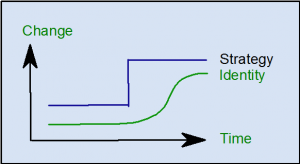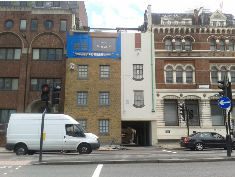 Just before Christmas, I was doing some last-minute shopping in one of the Oxford Street department stores. As usual at that time of year, there was a long queue for the checkouts. When I eventually got to a till, I was surprised to see two people there. There was a young man operating the till. And there was a tall older man bagging the goods sold. Although they were busy, you could tell that they were working well together, and enjoying exchanging a few words with customers and each other when they could.
Despite this, the older man had a gravitas that you associate more with the Board room than with the tills of a busy store. Not surprising really – he was a senior manager doing a shift supporting the front-line staff at their busiest time. What was surprising (apart from him being there at all) was the easy way he appeared to be accepted as part of the team.
Here was a real “one-team” culture in action. He was not just doing what the organisation expected. He was doing what he believed in, and so it came naturally. His colleagues saw it as perfectly natural and normal too. Everyone was comfortable, and it worked.
Culture is the pattern of behaviours that people adopt in order to be accepted in a community. It is defined by what people really value, not what they say they value. In that store, people really valued working together as one team to deliver happy customers. That meant that there was nothing awkward about managers working on the tills. Actions speak louder than words, and clearly it works for them.
Just before Christmas, I was doing some last-minute shopping in one of the Oxford Street department stores. As usual at that time of year, there was a long queue for the checkouts. When I eventually got to a till, I was surprised to see two people there. There was a young man operating the till. And there was a tall older man bagging the goods sold. Although they were busy, you could tell that they were working well together, and enjoying exchanging a few words with customers and each other when they could.
Despite this, the older man had a gravitas that you associate more with the Board room than with the tills of a busy store. Not surprising really – he was a senior manager doing a shift supporting the front-line staff at their busiest time. What was surprising (apart from him being there at all) was the easy way he appeared to be accepted as part of the team.
Here was a real “one-team” culture in action. He was not just doing what the organisation expected. He was doing what he believed in, and so it came naturally. His colleagues saw it as perfectly natural and normal too. Everyone was comfortable, and it worked.
Culture is the pattern of behaviours that people adopt in order to be accepted in a community. It is defined by what people really value, not what they say they value. In that store, people really valued working together as one team to deliver happy customers. That meant that there was nothing awkward about managers working on the tills. Actions speak louder than words, and clearly it works for them.
Walking the Talk
That experience prompted me to re-read Carolyn Taylor’s “Walking the Talk”, an excellent introduction to corporate culture. Here was an organisation that has a clearly-defined culture, and knows how to maintain it by walking the talk. Sadly, in my experience most leaders are better at the talking than the walking, and in any case most organisations don’t really know what culture they want (if they think about it at all). That’s a lot of value to be losing. As a professional change manager and consultant, I get asked to advise on how to bring about cultural change in organisations. Often, part of the conversation goes something like this:
“We really need to change how we do things. We just don’t have enough hours in the day to get everything done.”
“Yes, I can see that that would be a problem. I’m sure that there is a better way. It sounds like you need to delegate more. How comfortable are you with delegating to your managers?”
“That would be fine. But the problem is, our staff don’t have enough time for everything they need to do now either.”
“Hmm. You need a change programme – which you will need time and energy to lead – but you don’t have any spare capacity, and there is nowhere you can delegate stuff to free up some. So what parts of what you do now are you willing to see not being done at all to make the change happen?”
That often produces blank looks. But you have to devote time to leading change if you want it to succeed. You also have to lead by example. You have to demonstrate that change is a sufficiently high priority for you that it displaces other things. Other people are unlikely to change what they do until they see you changing what you spend time on, not just talking about doing so.
As a professional change manager and consultant, I get asked to advise on how to bring about cultural change in organisations. Often, part of the conversation goes something like this:
“We really need to change how we do things. We just don’t have enough hours in the day to get everything done.”
“Yes, I can see that that would be a problem. I’m sure that there is a better way. It sounds like you need to delegate more. How comfortable are you with delegating to your managers?”
“That would be fine. But the problem is, our staff don’t have enough time for everything they need to do now either.”
“Hmm. You need a change programme – which you will need time and energy to lead – but you don’t have any spare capacity, and there is nowhere you can delegate stuff to free up some. So what parts of what you do now are you willing to see not being done at all to make the change happen?”
That often produces blank looks. But you have to devote time to leading change if you want it to succeed. You also have to lead by example. You have to demonstrate that change is a sufficiently high priority for you that it displaces other things. Other people are unlikely to change what they do until they see you changing what you spend time on, not just talking about doing so.
Change needs time
Think of it like a sliding-tile puzzle. In a 4 x 4 puzzle there are 15 tiles, so that there is always one space to move the next tile into. That gives enough flexibility to rearrange all the tiles into the right pattern. If there were 16 tiles – completely filling the frame – nothing could move at all. You have to find an empty space in your time, like the missing tile, to be able to rearrange your organisational tiles. Like many things in life, this is just about priorities. If change is high enough up your priority list, it will displace other activities to create the necessary space. If it isn’t, it is best not to start. This seasonal message will help you to remember!
Last week I attended the inaugural meeting of the Change Management Institute’s Thought Leadership Panel. Getting a group of senior practitioners together is always interesting. I’m sure that if we hadn’t all had other things to do the conversation could have gone on a long time!
I have been thinking some more about two related questions which we didn’t have time to explore very far. What makes a change manager? And why do so many senior leaders struggle to ‘get’ how change management works?
Perhaps the best starting point for thinking about what makes a change manager is to look at people who are change managers and consider how they got there. The first thing that is clear is that they come from a wide variety of different backgrounds. Indeed, many change managers have done a wide variety of different things in their careers. That was certainly true of those present last week. All of that suggests that there is no standard model. A good change leader probably takes advantage of having a wide variety of experience and examples to draw on - stories to tell, if you will. Where those experiences come from is less important.
Then there is a tension between two different kinds of approach. Change managers have to be project managers to get things done. But change is not like most projects: there is a limit to how far you can push the pace (and still have the change stick) because that depends on changing the mindsets of people affected. Thumping the table or throwing money at it hardly ever speeds that up. Successful change managers moderate the push for quick results with a sensitivity to how those people are reacting. Not all project managers can do that.
So I think you need three main ingredients for a successful change leader:
- The analytical and planning skills to manage projects;
- The people skills to listen and to influence and manage accordingly;
- Enough varied experiences to draw on to be able to tell helpful stories from similar situations.
Senior managers and change
Why do many senior managers struggle to understand the change process? They may well have the same basic skills, but the blending is usually more focused on results than on process. That is not surprising; their jobs depend on delivering results. A pure ‘results’ focus may be OK to run a stable operation. Problems are likely to arise when change is required if the process component is too limited. Delivering change successfully usually depends on the senior managers as well as the change manager understanding that difference.
It was only in the latter stages of the referendum campaign that the penny dropped for me. I realised that the reason that the campaign was so much about emotion and so little about facts and likely consequences was that, whatever its ostensible purpose, the referendum had come to be about who we are. My identity is what I believe it to be, and what those I identify with believe it to be. The outcome of a referendum does not, cannot, change that, even if it can lead to a change of status.
It would obviously be nonsense if, when you asked someone whether they would be best off staying married or getting divorced, they stated their gender as the answer. Politicians have allowed a question about relationship to be given an answer about identity. Apples and oranges. In so doing they have shot themselves – and at the same time the whole country – in the foot.
 How do you do that? It is job of the vision you present to make people feel that they want to belong to the new future, and so to accept the discomfort of modifying their sense of identity. If people don’t buy into that vision, your chances of making the change successfully are low.
Whether or not it was deliverable, the ‘Leave’ campaign presented a simple vision of the future based on an identity which was clearly appealing to those disposed to believe it was. If ‘Remain’ presented a vision at all, it certainly did not make much attempt to sell an identity. It is reasonable to ask people about their identity, but we have representative democracy because you will still get the identity answer even if you ask them a relationship question.
If you want to bring about a successful change, start by making sure you have a believable vision which protects peoples’ identity and sense of belonging. Then campaign for that, even if it is not directly what the change is about.
How do you do that? It is job of the vision you present to make people feel that they want to belong to the new future, and so to accept the discomfort of modifying their sense of identity. If people don’t buy into that vision, your chances of making the change successfully are low.
Whether or not it was deliverable, the ‘Leave’ campaign presented a simple vision of the future based on an identity which was clearly appealing to those disposed to believe it was. If ‘Remain’ presented a vision at all, it certainly did not make much attempt to sell an identity. It is reasonable to ask people about their identity, but we have representative democracy because you will still get the identity answer even if you ask them a relationship question.
If you want to bring about a successful change, start by making sure you have a believable vision which protects peoples’ identity and sense of belonging. Then campaign for that, even if it is not directly what the change is about.
Identity and change
There is a profound lesson about change there. Identity is perhaps the ‘stickiest’ phenomenon in culture, because belonging is so fundamental to our sense of security. A change project is often perceived as changing in some way the identity of that to which we belong. However, peoples’ sense of identity changes much more slowly than the strategy. If we do not take steps to bridge the identity gap while people catch up, it is the relationship which is in for trouble. How do you do that? It is job of the vision you present to make people feel that they want to belong to the new future, and so to accept the discomfort of modifying their sense of identity. If people don’t buy into that vision, your chances of making the change successfully are low.
Whether or not it was deliverable, the ‘Leave’ campaign presented a simple vision of the future based on an identity which was clearly appealing to those disposed to believe it was. If ‘Remain’ presented a vision at all, it certainly did not make much attempt to sell an identity. It is reasonable to ask people about their identity, but we have representative democracy because you will still get the identity answer even if you ask them a relationship question.
If you want to bring about a successful change, start by making sure you have a believable vision which protects peoples’ identity and sense of belonging. Then campaign for that, even if it is not directly what the change is about.
How do you do that? It is job of the vision you present to make people feel that they want to belong to the new future, and so to accept the discomfort of modifying their sense of identity. If people don’t buy into that vision, your chances of making the change successfully are low.
Whether or not it was deliverable, the ‘Leave’ campaign presented a simple vision of the future based on an identity which was clearly appealing to those disposed to believe it was. If ‘Remain’ presented a vision at all, it certainly did not make much attempt to sell an identity. It is reasonable to ask people about their identity, but we have representative democracy because you will still get the identity answer even if you ask them a relationship question.
If you want to bring about a successful change, start by making sure you have a believable vision which protects peoples’ identity and sense of belonging. Then campaign for that, even if it is not directly what the change is about.
I once worked for a young organisation with big ambitions. The managers were all highly experienced, but had only recently come together as a team. They decided to contract with a long-established and very stable international firm to help with operations.
I don’t think anybody was expecting what happened next. The partner firm arrived, and immediately started to call the shots. Needless to say, hackles rose amongst my colleagues – we were the customer, after all: isn’t the customer always right? It took some considerable (and uncomfortable) time to make the relationships work.
What happened? This was all about organisational maturity. The partner organisation had well-established ways of doing things and strong internal relationships. Everyone knew what they were there to do, and how it related to everyone else. They knew that their colleagues could be trusted to do what they expected, and to back them up when necessary. That organisational maturity gave them a high degree of confidence.
My organisation, on the other hand, had none of that. Although individuals (as individuals) were highly competent and confident, there had not been time for strong relationships to develop between us. Although there would be an expectation of support from others, without having been there before certainty about its strength, timeliness and content was lacking. In those circumstances, collective confidence cannot be high. Eventually our differences were sorted out, but it might have been quicker and easier if the relative lack of organisational maturity and its consequences had been recognised at the start.
Confidence comes not just from the confidence of individuals. It is also about the strength of teamwork, and a team has to work together for some time to develop that trust and mutual confidence. When two organisations interact, expect their relative maturities to affect the outcome.
 Planet K2 shared this great TED talk about how limitations can help creativity. But how is that relevant to management?
As managers, we always have to work within many limitations: it is the nature of the world we work in. Contracts of all kinds; laws and regulations; stakeholder wishes; all constrain the freedom we have to act. If we see our job as managers being to make sure that we comply with all these requirements – some of which may well be conflicting, making that task ultimately impossible – there is a good chance we will start a downwards spiral of attempting ever-tighter control while only making things worse, as artist Phil Hansen found. We become more and more stressed, and less and less able to meet all those requirements.
How much better to recognise that while the limitations rule out some options, those very limitations can help us to focus our imaginations on the many other options which we may not have considered, but which remain available (and which, as Hansen found, can still present an overwhelming range of possibilities). When you squeeze the balloon, it pops out somewhere else. That requires us to have the courage to be creative, to try new approaches which have some risk of failure – but that makes success all the more satisfying and rewarding, as well as helping to free us to continue down the route of creativity.
Hansen found that what seemed to be the end of his dream of a creative life was in fact the door to whole new worlds of creativity. Rather than try too hard to work within our constraints, let’s use them to help us find the ways to better solutions, as he did.
Planet K2 shared this great TED talk about how limitations can help creativity. But how is that relevant to management?
As managers, we always have to work within many limitations: it is the nature of the world we work in. Contracts of all kinds; laws and regulations; stakeholder wishes; all constrain the freedom we have to act. If we see our job as managers being to make sure that we comply with all these requirements – some of which may well be conflicting, making that task ultimately impossible – there is a good chance we will start a downwards spiral of attempting ever-tighter control while only making things worse, as artist Phil Hansen found. We become more and more stressed, and less and less able to meet all those requirements.
How much better to recognise that while the limitations rule out some options, those very limitations can help us to focus our imaginations on the many other options which we may not have considered, but which remain available (and which, as Hansen found, can still present an overwhelming range of possibilities). When you squeeze the balloon, it pops out somewhere else. That requires us to have the courage to be creative, to try new approaches which have some risk of failure – but that makes success all the more satisfying and rewarding, as well as helping to free us to continue down the route of creativity.
Hansen found that what seemed to be the end of his dream of a creative life was in fact the door to whole new worlds of creativity. Rather than try too hard to work within our constraints, let’s use them to help us find the ways to better solutions, as he did.
For the last few weeks I have been posting about general principles of governance. Let’s turn to a practical example: How do those principles apply to programme management? There is of course no one ‘right way’ – it depends on the context. However, there definitely are ‘wrong’ ways, and they are all too common!
Most programmes have a Programme Director, and most have a Programme Board. What are their roles, and how should they be related?
Programme Board
The Programme Board should be a fundamental part of the governance structure. There would be no point in it being there unless it makes decisions. To do that, it must be given authority by some other body, which must itself have the authority to do that. Programme Boards typically have as part of their role resolving cross-functional issues for the programme. Consequently, they will normally be set up to report to a committee within the governance structure which itself has cross-functional representation. If the Programme Board is unable to resolve an issue which comes to it, normally its parent will need to. If a Programme Board were to report to an individual, it would be hard to see how that individual could more effectively resolve any cross-functional issue that had to be escalated.Programme Director
The Programme Director’s role will vary in detail between programmes, but fundamentally he or she is the person accountable for making sure that the expected outcomes of the programme are delivered within the constraints agreed. That leads us to two further points. First, if they are accountable, who will hold them to account? That is another part of the role of the Programme Board. The Programme Director will present progress reports, papers for decision, etc to the Programme Board, to enable them to do that. A corollary is that the Programme Director should be appointed, or at least confirmed, by the Programme Board, which will also delegate authority. If things are not going well, it is the Programme Board that must decide whether a change of Programme Director is required. Second, what is the nature of the relationship between the Programme Director and the Programme Board? Essentially it is like a contract. The Programme Board is the customer for the programme, approving the programme requirements. The Programme Director represents the delivery team - the contractor, if you will - and needs to make sure that sufficient time and resources are allocated to the programme to deliver the requirements. Clearly making the two join up may require negotiation. If there are subsequent changes to requirements, agreeing how to accommodate these – extra resource, recognising more risk, delay or reduced quality – will require a further negotiation. Remember, accountability and authority need to go together. Just as with the CEO and a company Board, it is clear that the Programme Director has a fundamentally different role to that of the Programme Board, and to blur these distinctions will introduce conflicts of interest. Of course the Programme Director will normally attend Programme Boards, although that does not mean that they have to be a member (and the different roles are clearer if they are not). Either way, though, they should never be the Chair: they would have a clear conflict of interest. At best they would be tempted to steer the agenda away from certain issues, and it would become impossible for the Board to be effective in holding them to account. No-one should be asked to mark their own homework! It follows that the members of the Programme Board should not normally be junior to the Programme Director, and certainly should not be his or her direct reports. Of course there is a place for meetings of the Programme Team – but those are progress meetings, not Programme Boards. Do your Programme Boards follow these rules? Walking along Blackfriars Road in London the other day, I realised that there was something odd about the very ordinary building I was passing. I must have walked past it quite a few times before, perhaps thinking about something else, perhaps looking the other way, perhaps just being unobservant – but this was the first time I had noticed.
How often are we so conditioned by what we expect to see that, so long as it more or less conforms to the norm, we build the oddities into our prevailing view rather than seeing things from a new perspective (curved window sills? A bit odd, maybe, but architects like to try out different ideas)? Change is difficult to implement, but the biggest problem is often getting started in the first place because people find it very hard to change the way they look at the issue, and so can’t see the need for a radical re-think. Another visual parallel is photographs of things like moon craters – do they go in or do they go out? Once you see it one way, it is hard to see it the other.
As a change agent, part of my job is to help people to see issues from a new perspective, and then to see that that new perspective leads to a new and better way of organising the response. If there is no new perspective, there is nothing to justify the change, and it is easy to see why people would choose to carry on as before.
If you still haven’t got it, look at http://www.london-se1.co.uk/news/view/7248 - or just try looking at the picture upside-down!
[contact-form][contact-field label='Name' type='name' required='1'/][contact-field label='Email' type='email' required='1'/][contact-field label='Website' type='url'/][contact-field label='Comment' type='textarea' required='1'/][/contact-form]
Walking along Blackfriars Road in London the other day, I realised that there was something odd about the very ordinary building I was passing. I must have walked past it quite a few times before, perhaps thinking about something else, perhaps looking the other way, perhaps just being unobservant – but this was the first time I had noticed.
How often are we so conditioned by what we expect to see that, so long as it more or less conforms to the norm, we build the oddities into our prevailing view rather than seeing things from a new perspective (curved window sills? A bit odd, maybe, but architects like to try out different ideas)? Change is difficult to implement, but the biggest problem is often getting started in the first place because people find it very hard to change the way they look at the issue, and so can’t see the need for a radical re-think. Another visual parallel is photographs of things like moon craters – do they go in or do they go out? Once you see it one way, it is hard to see it the other.
As a change agent, part of my job is to help people to see issues from a new perspective, and then to see that that new perspective leads to a new and better way of organising the response. If there is no new perspective, there is nothing to justify the change, and it is easy to see why people would choose to carry on as before.
If you still haven’t got it, look at http://www.london-se1.co.uk/news/view/7248 - or just try looking at the picture upside-down!
[contact-form][contact-field label='Name' type='name' required='1'/][contact-field label='Email' type='email' required='1'/][contact-field label='Website' type='url'/][contact-field label='Comment' type='textarea' required='1'/][/contact-form] 
